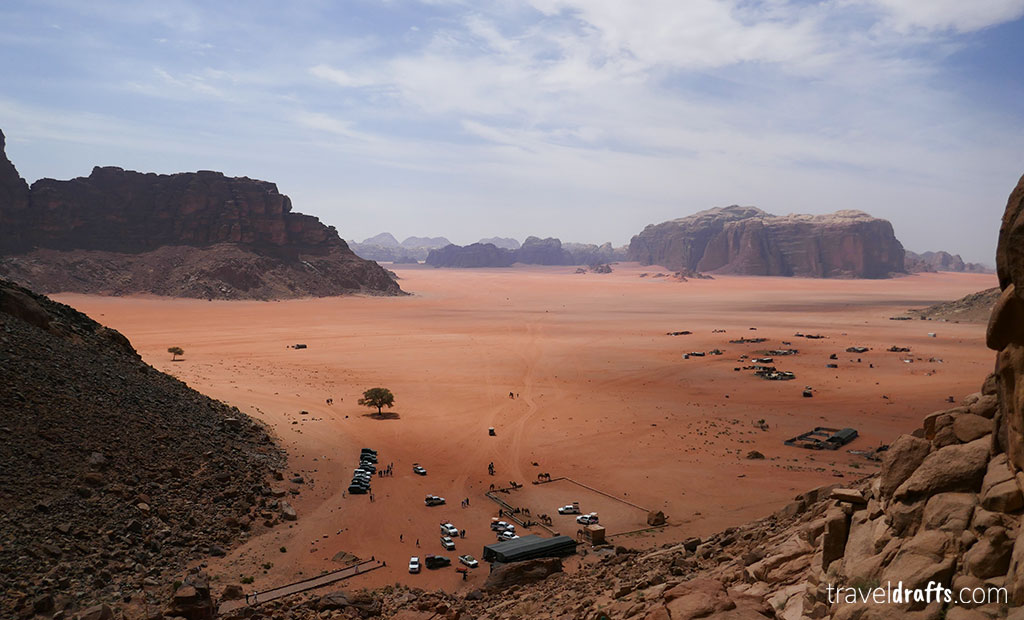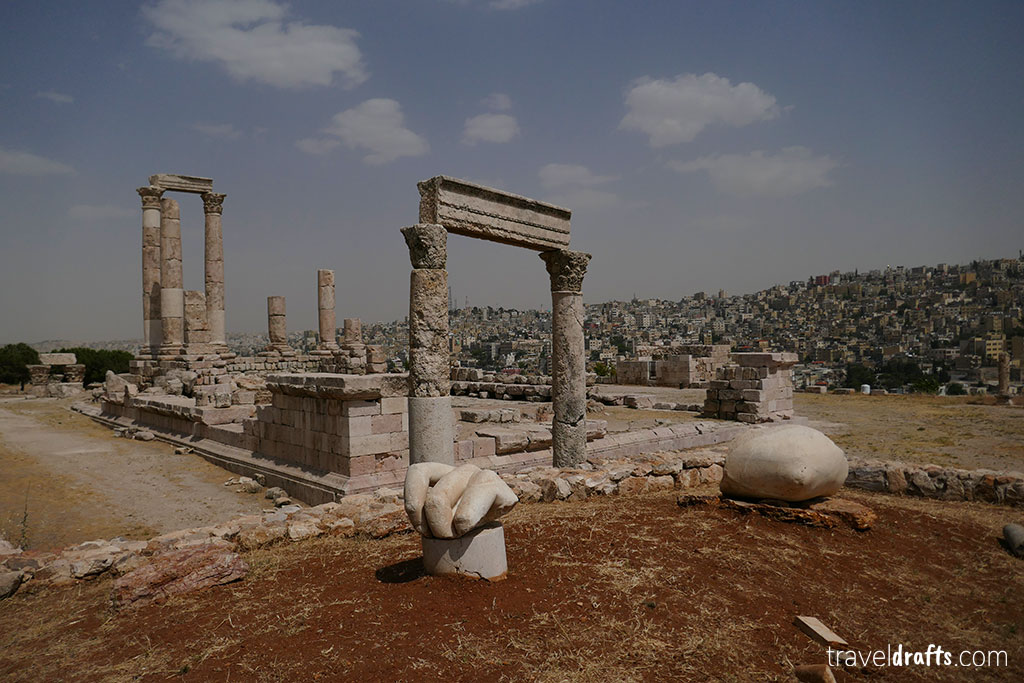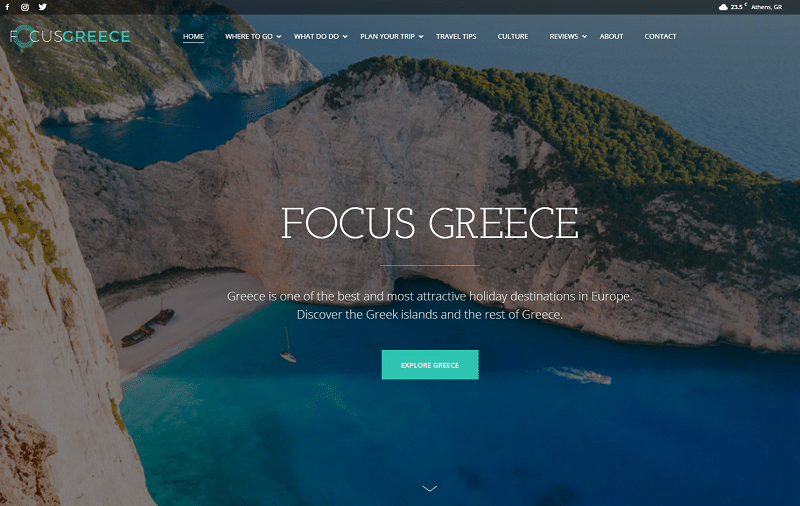#20 Famous landmarks in Jordan

Table of Contents
“20 Famous landmarks in Jordan”
There are quite a few things Jordan is famous for, some are wonderful, others are fascinating, and a few of them are landmarks. In this article, we will set aside the political, cultural, and historical things and want to explore the landmarks – the most famous landmarks in Jordan.
Jordan is a beautiful country with a wide range of remarkable landscapes, including deserts, lakes, coral reefs, rivers, seas, and mounts. It is also known for its long conturbed history and all the monuments and ruins that come with it. There are several significant religious landmarks (Jewish, Christian, Muslim), but also roman and greek ruins, templar fortresses, ancient cities…
For such a small country, Jordan has an astonishing diversity of human-made and natural landmarks. For this reason, we invited a few other bloggers to pitch in more landmarks in Jordan and make this post as complete as possible.
Without further ado, let’s explore the 20 most famous Jordan Landmarks!
Famous landmarks in Jordan – Natural
Wadi Rum
Wadi Rum desert is one of the most beautiful natural landmarks in the world, it is known as the Valley of the Moon. It has such a unique landscape of red sand desserts and huge sandstone and granite mountains. It makes you think that you are on another planet, so it is not surprising that it was chosen as the setting for the films The Martian, Dune, and Star Wars.
Wadi Rum is home to the Bedouins who in the past had a nomadic life. Nowadays they are responsible for the preservation of Wadi Rum, which is classified as a protected area since 1998. To visit Wadi Ram you need authorization and can only visit it with a guided Bedouin tour. The wadi rum tours usually include 4×4 trips, camel rides, and overnight in a Bedouin camp in the desert. It is truly an experience, we highly recommend staying at least one night in the desert.
Wadi Rum became very famous due to its connection with T.E. Lawrence and the Arab revolt in 1917. There are even several spots that reference this period of time, like the “Seven Pillars of Wisdom” rock formation, and Lawrence’s spring. Wadi Rum also has some archeological sites of the Nabataean period like a temple and marks in the form of petroglyphs inscriptions in Khaz’ali Canyon in Wadi Rum.
Wadi Rum is really an amazing place – it has to be on anyone’s bucket list. If not for anything else, Wadi Rum would be enough of a reason to come to Jordan.

Dead Sea
The Dead Sea is one of Jordan’s most famous natural landmarks, and one of the world’s natural wonders. It is shared between Israel, Palestine, and Jordan, as it bathes the three territories.
Famous for its extreme salinity levels, and being below sea level, the Dead Sea is also a unique destination in Jordan, where one can easily float in its waters. The Dead Sea banks are considered the lowest place on Earth at an altitude of about 430 meters below sea level. Going there is remarkable on its own – you look at the top of the hills and they are still way below sea level.
The Dead Sea is also one of the saltiest bodies of water in the world, and certainly the largest among the very salty places on earth. The salinity levels reach 34% or about 10 times more than the sea. This has two consequences:
- Float is effortless – you can easily read a book or a newspaper while floating, and it is very hard to swim;
- There’s no life inside the dead sea, which explains its name.
Viewing the Dead Sea is easy, you just need to drive the Dead Sea Highway and enjoy the view. On the Jordan side, if you want actually to go into the water, you have to stay in one of the many resorts on the north section of the dead sea, which are very expensive; or go to one of the wild beaches, which don’t have shades or freshwater to shower. Unfortunately, there are no public beaches, as there are in Israel.
If you don’t have a car, it is possible to visit the dead sea on an organized tour.

Jordan River
The Jordan River is the biggest tributary of the Dead Sea, but it is so much more than that. It flows from north to south, from the Golan heights through the sea of Galilea (this is the upper Jordan river), and then from the Sea of Galilea to the Dead Sea (the lower Jordan River).
The Jordan River used to be much larger, with a high water flow. According to estimates the flow rate of the Jordan River used to be about 1.3 billion cubic meters per year, while in the last decades it doesn’t surpass the 30 million cubic meters per year. This caused the river to become far less impressive, and the dead sea to recede.
Nevertheless, it still is a major landmark in Jordan and the Middle East – it is so important that the county was named after the river. The main reason behind the reduced water flow is that the water is being used for agriculture by all the territories around.
With 251 kilometers (156 mi) river, the Jordan is rather small, it is one of the most famous rivers in the world. It holds significant meaning for Judaism and Christianism. According to the bible, the Israelites crossed the Jordan into their Promised Land, and it was in the Jordan River that Jesus of Nazareth was baptized by John, the Baptist.
The place of baptism is also situated in Jordan, and referenced on this list below. It is possibly the best place to see the Jordan River as most of the river goes through delicate military areas of very restricted access.

Jordan Grand Canyon
Another important tributary of the Dead Sea is Wadi Mujib, also known as the Arnon stream in Hebrew. This river cuts through the Jordan altiplano creating a massive Canyon – sometimes called Jordan’s Grand Canyon.
At its largest point, the Jordan Grand Canyon is massive. It is almost 1 km deep and more than 3 km wide. It is also an easy Jordan landmark to access, as the popular King’s Highway crosses it. There the highway plunges through twists and winds about 900 meters from the top of the rim to cross the wadi in the recently built dam. Afterward, it immediately climbs to a similar altitude and with several hairpin turns. It’s quite a fun drive.
Both in the northern and southern rims there are lovely lookouts where one can enjoy the breathtaking views. We particularly enjoyed having a coffee at “Sami’s Best Coffee & Rest Grand Canyon Viewpoint”. It was probably the best coffee with a view that we have ever had.

Wadi Mujib slot canyon
The lower part of Wadi Mujib is completely different but also spectacular, maybe even more. After being the largest canyon in Jordan, Wadi Mujib becomes a slot canyon only a few meters wide, where the water flows.
Before running off to the dead sea, the last kilometers of the wadi are stunning, with soft orange, red and yellow rock walls that create one of Jordan’s most beautiful natural landmarks. It has rapids, waterfalls, hiking trails, and scenery similar to some of Utah’s and Arizona’s landmarks.
It is possible to explore the Wadi Mujib slot canyon through the Siq trail. In this trail, you start at the mouth of the wadi and hike your way through about 1.5 km until reaching a large waterfall. You’ll need to get wet, swim, slide, and do canyoning. It is one of the most fun activities, in one of the most beautiful places in Jordan.
If you have a car, it is very easy to reach the Wadi Mujib adventure center, though if you don’t, it can still be easily done through a tour like this.

Aqaba coral reef
The Aqaba coral reef is located in the Red Sea, along the coastline of the Gulf of Aqaba on the Southern tip of Jordan. The reefs of Aqaba contain a colorful world of sea coral, tropical fish, and a diversity of habitats and ecosystems.
Sadly coral reefs are decreasing worldwide, but Jordan is making an effort to preserve the corals and the marine life that inhabits them. Jordan is seeking to announce the corals of Aqaba as a UNESCO natural heritage site. But much more is needed to be done, especially in terms of pollution and sea cleaning.
The corals, the marine life, the favorable climate, and the warm sea make Acaba a popular tourist destination – an ideal place for nature lovers. Plus, it has incredible spots for snorkeling and diving. Besides the coral, there are some renowned dive sites such as the shipwreck, the sunken tank, and the Japanese gardens. Aqaba has 23 dive sites, 21 of which lie within the boundaries of the Marine Park.
The best place to observe the coral reefs in Aqaba is in South Beach, as it is where you will find the shipwreck and the Japanese gardens. The beach has good infrastructure, sunshades, places to change clothes, and a place to rent snorkeling equipment. You also have the option to do a glass boat trip and observe underwater fish and corals or opt to do diving lessons. There are several centers in Aqaba with options for deep diving.
Aqaba is also a good place to relax and enjoy the hot sea. Be aware that Aqaba is very hot, especially in Summer.

Dana Reserve
By Ellis from Backpack Adventures
The Dana Nature reserve is one of Jordan’s most beautiful and largest nature reserves. Although less famous than Petra or Wadi Rum it certainly offers equally stunning landscapes and it is home to a variety of Jordanian wildlife. It’s heaven for birdwatchers and those interested in reptiles.
Dana village is the gateway to the nature reserve. With its ancient stone houses it is very scenic and only a short detour from the King’s highway. With its convenient location midway between Amman and Petra, it is surprising that not many people visit this beautiful place.
The Dana Biosphere Reserve is one of the best places in Jordan to go hiking with a number of established hiking trails. One of the most popular trails is the Wadi Dana trail.
This 16-kilometer hiking trail through the Dana gorge follows a dry riverbed. When hiking you may come across strange plants, flowers, and trees as well as the possibility to spot lizards and maybe even ibex or the elusive sand cat if you are lucky. Wherever you go, you have beautiful views of the red rock formations that surround the Dana valley.
The hike ends at the Feynan Ecolodge in the middle of the desert. It’s an up-market place but well worth the cost. Budget travelers can take a taxi back to Dana where there are a number of budget hotels.
There are more challenging hikes deeper into the reserve that are even more spectacular but they require a guide. The guides in Dana can tell you a lot about the unique flora and fauna of the reserve.

Landmarks Jordan – Castles
Ajloun Castle
Ajloun Castle is a cool Muslim castle built in the 12th century under the rule of Sultan Saladin. It was built to protect the territory against the Crusaders and to control the road connecting Damascus and Egypt. The castle was subjected to plenty of invaders (including the Mongols) and several restorations. Due to that, the castle does not contain its original features from its origins in the time of Saladin. Even so, the castle is such an interesting visit, especially for anyone that loves history.
The castle is open for visitors, and you can reach it easily from Amman taking only 1h30 by car, making it an ideal day trip from Amman. Ajloun Castle is very well preserved and restored. Inside the castle, there is a museum with artifacts from various time periods of the region. The castle also has extensive explanations of how the castle was defended, its secrets, and the history of the castle, which is very interesting. It is also a fun place to visit with kids as it will allow them to explore the different rooms and imagine life inside the castle.
On top of the castle, you will find amazing views of the Jordan Valley, the desert, and the olive oil trees surrounding it. Nearby there is the Ajloun Forest Reserve, which is a beautiful nature reserve great to do hikes. And just about 40 min by car the city of Jerash, which has an outstanding archeological site.

Shobak Castle
Shobak Castle is one of Jordan’s most popular castles. Located along the popular King’s highway it is one of the most typical stops on the way to/from Petra.
Originally constructed by the Crusaders and later expanded by the Mamluks, the Shobak Castle is also known as Montreal, as it was the name the crusaders gave it, meaning Royal castle. This crusader castle was built perched on the side of a rocky, conical mountain, by order of King Baldwin I of Jerusalem in 1115.
The remote location and the desert make this castle particularly striking, though today the modern city of Shoubak is relatively close. The castle is mostly in ruins, but it is fun to explore the grounds, the watchtower, the catacombs, and even the secret passageway to a spring. It is possible to hire a guide if you feel you want to learn more about the building and its history.

Kerak Castle
Kerak Castle is one of the largest castles in the Levant, it was built in 1140 and belonged to the crusaders. It is one of Jordan’s most famous attractions and is located on the King’s highway on the way to Petra, making it a mandatory stop.
The castle was built on top of a mountain and is surrounded by steep hills, it has an ideal strategic military point. It was used to control and defend the trade routes from Damascus to Egypt and Mecca. The castle is a heritage testament to the crusaders’ architecture and their defensive technics. In 1183 there was a famous siege of the castle led by the forces of Saladin. The castle, later on, belonged to the Ayyubid, Mamluk, and the Ottomans, so it now has a mixture of Byzantine and Arab designs.
Subject to large restorations, today Kerak Castle is a fascinating landmark and a fun visit for adults and children. It has stone-vaulted halls, a fortified tower, and cool underground passageways. It is definitely a Jordan landmark to visit and explore.

Qasair Amra
By Eva Westerling from Not Scared of the Jetlag
At the time the Qasair Amra was built, Jordan was most likely still very green with many animals roaming around. Imagine being on a hunting trip with your friends and returning to the lodge, with frescoes and paintings of animals and people all over the walls. In the evening you enjoy a bath in the hammam that is directly attached to the main building. You look up to the ceiling and see the stars painted on the dome of the bathhouse.
Most of this is still visible in Qasair Amra, just off the highway to Syria and Iraq. The title “desert castle” is a bit misleading, as the building is rather small and does not resemble a castle as we imagine them.
The Qasair Amra has been listed on the UNESCO world heritage list since 1985 for its unique Islamic art from the Ummayad period.
Next to the car park is a small museum that explains what you see in the castle, so you should visit this first. The entrance is 3 JD and includes the other castles as well.
Around 100 km from Amman, the only way to get there is by car, so you can either rent one or book a day trip that would also include the other desert castles.

Jordan Famous Landmarks – Archeological sites
Petra
Petra, the “Rose City”, is one of the new seven wonders of the World and a UNESCO world heritage site. It is one of the most famous archaeological cities in the world, attracting millions of tourists per year. And it is easy to understand why – It is a beautiful and unique place that leaves a huge impression on anyone who visits it.
Petra was the capital of the Kingdom of the Nabataeans. Located in a strategic spot on the incense trade route, it was the center of the caravan trade. The Nabataeans were nomadic Arabs, skillful traders who made fortune by trading and charging taxes on passing caravans through Petra. Besides traders, they were brilliant rock-cut architects and good in the construction of water conduit systems. They transformed Petra into an Oasis with water canals and dikes.
The Nabataeans built Petra in the 4th century BC, they carved spectacular structures into the sandstone which can rise to 40 meters. They built several buildings that were Mausoleums, honoring their kings. The most famous is the Al-Khazneh “The Treasury” which was the mausoleum of the Nabatean King Aretas IV. But Petra is surrounded by dozens of spectacular Royal Tombs carved in the mountains.
Petra fell under the Romans who used the city and constructed new buildings like a theater and several temples. The Byzantine era succeeded and several Christian churches were built. And eventually, the city was abandoned, with only remaining Bedouins.
Going to Petra is a surreal experience, the first impression when you arrive is unforgettable. You have to walk through a 1.2 km long Siq which leads to the breathtaking Al-Khazneh “The Treasury”. To visit the city you will need a whole day as it is huge and you have so much to visit. The Royal Thombs, the Roman Theater, the Byzantine churches, and the Ad Deir “The Monastery” which you have to climb 800 step path to reach. Petra is worth all its fame – it is a magical place.

Jerash Archeological site
Jerash Archeological site is considered one of the largest and most well-preserved sites of Greco-Roman architecture. Its size, extent of excavation, and level of preservation are impressive. It is nicknamed “the Pompeii of the East”, although it wasn’t buried under volcanic ash it is very well preserved. It is big and imposing, it is a place you can’t miss.
Located in Northern Jordan, only 48 km from Amman, it is an ideal day trip from the capital. And you will need plenty of time as it has so many archeological points to see. Jerash is thought to be found by Alexander the Great, but it is uncertain. In 63 BC it was conquered by the Romans, which ensured security and prosperity. Enabling the city to develop economically and to construct and expand it.
The city has imposing gates, colonnaded avenues, temples, theatres, Hippodrome, Hadrian’s Arch, and public baths. Later on the city, in the 3rd century, the city was ruled by the Byzantine empire, the Muslims took over the, but in 1112 after an attack of the Crusaders, it was abandoned.
Jerash Archeological site is an open window to the past, you can imagine how and where the Greeks and Romans lived. It is an enriching experience. Be aware the archeological site is very exposed to the sun and doesn’t have enough shadows, so it can be very very hot. Take plenty of water, and hats and avoid the peak hour of the sun.

Umm Qais
Umm Qais is another archeological site in Jordan worth visiting. Located in the far north of the country, near the border with Israel and Syria, it was once the thriving Roman city of Gandara. This picturesque Jordan landmark attracts thousands of people every year, yet it is much less crowded than the other archaeological sites on this list.
Gandara was located on a hilltop, about 370 meters above sea level boasting panoramic views across the Sea of Galilee and the Golan Heights. It is strategically located close to several sources of water, which helped make it significant in ancient times.
Besides the lovely views, Umm Qais offers some interesting ruins to see and explore, including a Roman Theatre, Colonnaded streets, Roman Tombs, the Basilica terrace, and an Ottoman Village. As it isn’t as crowded as others sites, and it is a large place, it feels much more private making the experience more authentic.
Umm Qais is about 2 hours from Amman and can be visited privately or through organized tours. It is popular to visit Umm Qais together with Jerash and Ajloun Castle (both also on this list).

Amman citadel
Amman citadel is an Archeologic site in downtown Amman on top of the highest hill. Inhabited since the Bronze age, then the Romans, Byzantine, and Umayyad. It is considered one of the world’s oldest continuously inhabited places.
The citadel has several archeological landmarks that you shouldn’t miss like the Roman temple of Hercules, the hand of Hercules, the Byzantine church, the impressive Umayyad Palace, and the water cistern. On the site, there is also a Jordan Archaeological Museum, which although rather small, has several artifacts of different periods of time and it is a good place to rest and refresh yourself.
A visit to Jordan isn’t complete without a visit to Amman Citadel, besides its historic importance and impressive buildings, it has amazing views of the entire city of Amman.

Umm Al-Jimaal
By Anwar from Beyond my Door
Mother of Camels, or how Umm Al-Jimaal is translated into English. This large old black basalt city feels both modern as well as ancient. This ancient city dates back to the Nabataean times as a village on the outskirts of Bostra. It lasted through the Roman era and many civilizations until the 8th century when a large earthquake destroyed much of the city. Some period after the earthquake the city was abandoned and has remained so for over 11 centuries.
The city itself was left, however much of the area around has been built up during more modern developments. You can see much of this around the outskirts of the town.
There isn’t anything specific to see in the city beyond the ruins. But the ruins themselves are impressive and worth wandering about. Due to the low number of visitors, it’s quite possible to be the only visitors to the site that day.
The city is located about 20 kilometers outside to eastern desert city of Mafraq in Northern Jordan along the Baghdad International Road. Bus transportation exists however you’ll need to specify to the bus to drop you near the ruins and walk the rest of the way. It is also possible to get a taxi from Mafraq to the ruins (ask the driver to wait as finding a return taxi will be difficult). Driving is the preferred method as other transportation can be sporadic.
Famous Landmarks of Jordan – Other
Baptism Site “Bethany Beyond the Jordan” (Al-Maghtas)
The Baptism site or Al-Maghtas (which means baptism in Arabic) is a religious archaeological site. It is considered to be the original location of the Baptism of Jesus by John the Baptism. It is located on the east bank of the Jordan River, nine kilometers north of the Dead Sea.
The site is classified as a UNESCO World Heritage site since 2015. And has received the blessing of the Christian and Orthodox Church, moreover, four Popes have visited the site. On the Baptism site, you will find remains of a monastery, churches, and baptism ponds.
You are not allowed to visit the site without a guide, but when you buy the ticket it includes the guide and a short bus trip to the local. First, you will pass by the archaeological site, that doesn’t have water – the Jordan River doesn’t pass there anymore. Then you will have to do a short walk to the actual river Jordan. If you want you can dip in the river religious artifacts or tokens or even be baptized if you wish but you need the authorization of the guide and need to use clothes designed for the occasion.
The site receives millions of tourists per year, and even if you aren’t a pilgrim or religious, it is an important historic landmark.

Mount Nebo
Located about 30 km from Amman (50 minutes), and only 10 km from Madaba (15 minutes), Mount Nebo is one of the most famous landmarks in Jordan. The location between Madaba and the Dead Sea makes it an easy visit. It is also included in many organized tours, as Madaba, Mount Nebo, and the Dead Sead go together perfectly for a day trip from Aman.
Elevated about 710 meters above sea level (meaning more than 1100 meters above the Dead Sea) it grants magnificent, panoramic views of the Jordan River valley, including the dead sea and all surrounding areas in Jordan, the West Bank, and Israel. Jericho, the oldest city in the world is usually visible from mont Nebo, and on very clear days even Jerusalem.
Mount Nebo carries huge religious significance. It is believed that it was on Mount Nebo where Moses saw the Sacred Promised Land, before his death. So, there you can see what Moses saw. There are also a few other interesting sights like the collection of Byzantine mosaics, Moses memorial church, and the Brazen Serpent.

Roman theatre, Amman
The Roman Theatre is arguably the most impressive landmark in Amman. Constructed in the second century CE, it dates back to the period when the city was known as Philadelphia and part of the Roman Decapolis, the city’s league on the frontier of the Roman Empire in the southeastern Levant.
With a capacity of 6000 seats spread through 3 horizontal sections with 44 rows, it is a massive building that is still well conserved. It is even used as a venue for cultural activities. The theatre was built on a hillside, turning north to keep the sun off the spectators.
The Roman Theatre is located in the center of Amann and is easily reachable by car and public transport. In front of it, there are remains of the colonnades of the Roman Forum, and a huge public square (100×50 meters) that used to be one of the largest of the Roman empire.
One of the best ways to know the roman Theatre and other landmarks in Amann is by doing a private tour like this.

Map of Madaba
The city of Madaba located about 50 km south of Amann is one of the most pleasant in Jordan. It has plenty of things to do and see, and it is close to several important landmarks. The city itself is home to a few attractions like the burnt church, and the church of the apostles. However, the most famous landmark is clearly the mosaic map of Madaba.
Madaba is known for being the city of mosaics, with many of its attractions featuring incredible mosaics from several different epochs. Even today it is an important sector of the economy. However, the most famous mosaic is found in the Orthodox church of Saint George, the Map of Madaba. This 6th-century mosaic map features the whole region from Lebanon in the north to the Nile delta in the south, and from the Mediterranean Sea to the desert in the east.
Rediscovered in the 19th century, the mosaic map of Madaba has been considered one of the most important archaeological finds in the Middle East and one of the oldest pieces of evidence of cartography. Unfortunately, only about one-fourth of the map is preserved.
The mosaic is a complex work of art, and definitely a significant finding, but you should note that visiting is a bit underwhelming, as it is simply a mosaic on the ground of a church. It is in greek, and a large chunk wasn’t saved so it is difficult to examine. On the upside, you can see it very closely, which is rare in this kind of work.
Madaba and the mosaic map are very easy to visit both by car and on a tour. It is a typical day trip from Aman, which usually also includes Mount Nebo, the Dead Sea, and the Baptism site. Have a look at a few options here.

Pin it for later
If you liked the article, do not forget to share it with your friends. Follow us on Google News too, click on the star and choose us from your favorites.
For forums sites go to Forum.BuradaBiliyorum.Com
If you want to read more Like this articles, you can visit our Trip & Travel category.




